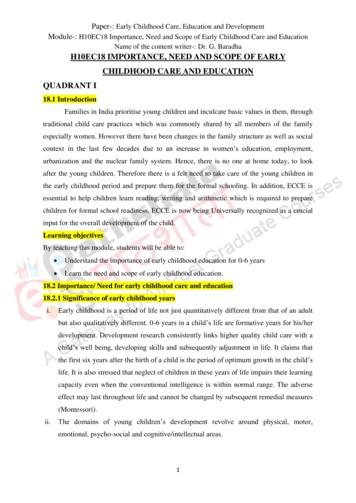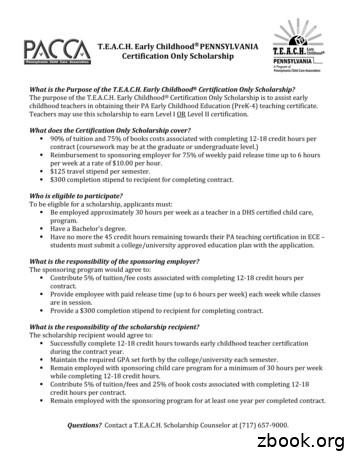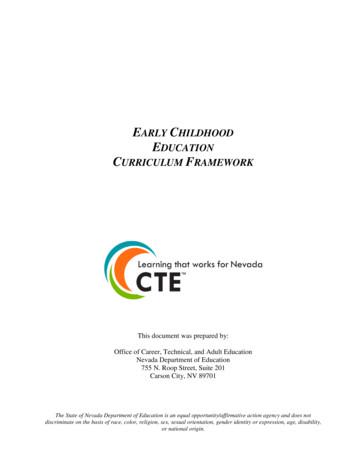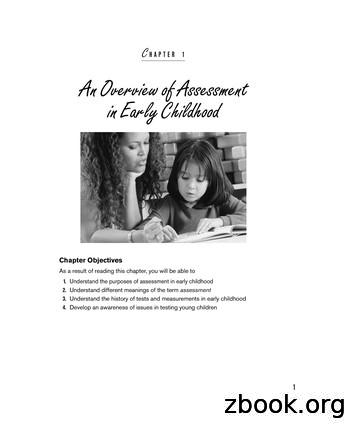Early Intervention/ Early Childhood Special Education
September 2020Early Intervention/Early ChildhoodSpecial EducationCOMPANION GUIDANCE TOREADY SCHOOLS, SAFE LEARNERS ANDCOMPREHENSIVE DISTANCE LEARNINGALIGNING FEDERAL AND STATE REQUIREMENTS
Table of ContentsIntroduction . 2Limited In-Person Instruction . 3Required Health Services . 4Child Find, Referral, Evaluations and Eligibility. 5Individualized Family Service Plans (IFSP) . 6Specially Designed Instruction . 8Related Services under IDEA. 9Transportation as a Related Service . 10Progress Monitoring . 10Compensatory Services or Recovery Services . 11Social and Emotional Behavioral Supports . 12Staffing . 13Children With Disabilities in Private Schools Placed or Referred by Public Agencies . 13Future Updates . 14Acronyms and Definitions. 15Checkboxes ( ) indicate requirements; arrows ( ) indicate recommendations.Bullets denote considerations or potential actions.1
IntroductionThe context for early care and education is much different than that of K-12, given thatenrollment for learners under the age of 6 in a particular early care and education program isnot compulsory. Additionally, the Early Care and Education System is made up of manydifferent connected systems and a variety of ways in which young children and their familiesreceive access to high quality early care and education. This includes publicly funded programs(Oregon Pre-Kindergarten [OPK], Head Start/ Early Head Start, Relief Nursery, PreschoolPromise, Baby Promise, district-based PreK, and Early Childhood Special Education Classrooms),child care (Certified Family, Registered Family, licensed or exempt Center-Based Care), andfamily, friend or neighbor care. Within each of these contexts for early care and education,young children with disabilities are learning, growing, and developing alongside their same agedpeers, within their community, and with trusted adults.Students protected under Individuals with Disability Education Act (IDEA) are guaranteed a FreeAppropriate Public Education (FAPE) to all eligible learners. IDEA has two main components: (1)Part C, which covers infants and toddlers experiencing disabilities; and (2) Part B, which coversall learners, age three to 21, experiencing disabilities who are found eligible for educationalservices.During COVID-19, the requirements and protections under IDEA Part B and Part C have notbeen altered. Schools, districts, and ESDs must still consider the most effective ways to provideParent Participation opportunities, Identification and Evaluation, FAPE, Least RestrictiveEnvironment (LRE), and Procedural Safeguards for students protected under IDEA. EarlyIntervention/Early Childhood Special Education (EI/ECSE) and other early learning programs andproviders that offer education and partner with families have continued to provide support andlearning opportunities for children in a variety of ways. As we move towards the fall,engagement, intention, and service delivery must evolve. Districts and ESDs that provideservices for young children with disabilities must develop plans for moving in and out of theinstructional models as highlighted in Ready Schools, Safe Learners. This effort will requirecritical innovative thinking, imagination, and collaboration across sectors with increasedpartnership with families.The following guidance addresses requirements and recommendations for EI/ECSE contractorsand subcontractors to provide high quality intervention services to families and young childrenwho experience disability. This guidance is a companion to the Ready Schools, Safe Learners(RSSL), Comprehensive Distance Learning (CDL), and the Health and Safety Guidelines for ChildCare and Early Education during COVID-19 Pandemic.This guidance does not reiterate RSSL, CDL, or Early Learning Division (ELD) guidance, but ratherto clarify how to implement them for a specific population within this new paradigm. OregonDepartment of Education (ODE) worked with internal and external partners to address criticalaspects of delivering services and recognizes that districts have unique local contexts that willinform how to apply this guidance.Checkboxes ( ) indicate requirements; arrows ( ) indicate recommendations.Bullets denote considerations or potential actions.2
What this document is: Guidance that will change and grow basedon local trends and statewide data Informed by engagement, evidence, andexpertise Essential actions designed to spur thinking,planning, and prioritizing Part of a continuum of school decisionmaking Supplemental to Ready Schools, SafeLearnersWhat this document is not: Legal advice An exhaustive list of actions required toreturn to school A distance learning playbook or schoolclosure guidance The final word on how schools willmanage the next phases of COVID-19Those who serve children who experience disability must also consider how to recognize andmeet the strengths and challenges experienced by learners who have been historicallymarginalized by educational systems. Within these groups are children and families whoidentify as Black, Indigenous, People of Color (BIPOC), are emergent bilingual students, studentsof migrant and farmworker families, students in foster care, students who have an incarceratedloved one, and students experiencing houselessness. The varied intersections of race andethnicity, socioeconomic status, and disability have the potential to impact opportunities andcompound discrimination and oppression.Equity must live at the heart of every decision and every action in service of the children andfamilies we serve. This means recognizing and leveraging the assets, roles, and strengths oflearners and their families, including native language. It means strengthening relationshipswith community partners, school districts, educational association leaders, tribal nations, andbusiness and industry partners. It means heightening attention to groups of students who bearthe burden of an inequitable health and educational system. As we experience a worldunfamiliar to us all, we will find innovative ways to support our students and staff.Limited In-Person InstructionFor EI/ECSE, services can include assessment, specially designed instruction, and relatedservices. Limited In-person Instruction is not synonymous with in-home services. Furtherguidance on home visiting is forthcoming. Decisions regarding Limited In-Person Instruction arelocally determined based on a variety of local factors and individualized considerations forfamilies and children.Checkboxes ( ) indicate requirements; arrows ( ) indicate recommendations.Bullets denote considerations or potential actions.3
Required Health ServicesAll programs must account for students who havehealth conditions that require nursing and otherhealth services in each instructional model.Provision of health services to a student may berequired per a student’s IFSP under IDEA.Required Determine whether a student would benefitfrom the provision of any service viatelehealth. This may require that licensedstaff: Conduct additional assessment andevaluation of the student and theirlearning environment. Update student’s individualized healthplan or other provider required plan ofcare. Align services via tele-health with applicablelicensing board rules. See provider specific telehealth guidanceon the ODE website. Provide therapy and other related services(registered nurse, occupational therapist,physical therapist, speech languagepathologist) when they are determined to benecessary per a student’s IFSP in order for thestudent to access FAPE. In comprehensive distance learningmodels, this may be accommodatedthrough either Limited In-Personinstruction or provision of in-homeservices. Specific services required in order toaccess FAPE may be different given plansfor the 2020-21 school year (i.e., somestudents may require additional services;for some students, some services may nolonger be required). Align with FERPA and HIPAA privacyrequirements. See: Student Privacy Considerations andDistance Learning for All.Figure 1: Key considerations for engaging inlimited in-person instructionCheckboxes ( ) indicate requirements; arrows ( ) indicate recommendations.Bullets denote considerations or potential actions.4
Recommended See Resource Toolkit for Students with Complex Needs for more information about servingstudents with complex needs. Seek Medicaid reimbursement for allowable health services that are provided both inperson or via telehealth. See ODE School Medicaid Resource page.Child Find, Referral, Evaluations and EligibilityRequired Review current policies, procedures, and protocolsConsider the impact of theregarding referral and evaluation processes for possibleExtended School Closure andrevision.changes in educational Involve impacted stakeholders in the policy review and trainenvironments on studentall staff regarding any new policies, procedures, orlearning and growth. Allprotocols.students likely experienced Maintain all intake lines for referrals and respond to parentsregression in some mannerwithin 48 hours or as soon as feasible.due to the Extended School Prioritize evaluations for children transitioning from EI toClosure. Such regression is notECSE, and any evaluations that were delayed or interruptednecessarily indicative of adue to the extended school closure.disability that requires special Finalize any eligibility for evaluations completed prior to theeducation.school closure. Review student performance after initiation of on-siteeducation and services. Use the appropriate code if timelines are delayed due to access and closure related toCOVID-19 (see the Child Find Manual, pg.14). Districts and ESDs can also continue to use the “GC” code found in EcWeb for EI/ECSEevaluations. Prioritize conducting eligibility meetings virtually or over the phone. When in-personmeetings are chosen as an option through Limited In-Person Instruction under CDL, addressthe home languages of families who require translation of printed material or an interpreterfor spoken meeting, have limited virtual or phone access, or who require additionalaccommodations to fully participate. Note the State of Emergency circumstances under which the evaluation was completed andnote adaptations to typical test administration procedures on the evaluation report. Inform members of the Eligibility team where reliability of assessment results may beimpacted (e.g., due to administration procedures). (OAR 581-015-2115 Evaluation Planning,OAR 581-015-2100 Responsibility for Eligibility)Recommended Consider the impact of the Extended School Closure and changes in educationalenvironments on child learning and growth. All children and families have likelyCheckboxes ( ) indicate requirements; arrows ( ) indicate recommendations.Bullets denote considerations or potential actions.5
experienced regression in some manner due to the Extended School Closure. Suchregression is not necessarily indicative of a disability that requires special education.Develop a plan to initiate and complete evaluations during Limited In-Person instructionunder allowable exceptions or when shifting to on-site instruction.Consider continuing eligibility for students previously identified with Developmental Delay(DD) through age 9; this will minimize unnecessary evaluations.Determine if the proposed evaluation can be completed using alternate sources of data,thus minimizing the use of standardized assessments.Choose a tool that is sensitive to incremental skill growth and use it in conjunction with anintervention plan that is designed to address the student’s social, emotional, or behavioralskill deficit when the use of standardized rating scales is necessary. By administering theassessment before and after targeted interventions, the student’s rate and degree of skillgrowth can be analyzed and used to inform the evaluation.Review information to make ECSE eligibility determination (past information, parentinterview, file review and virtual assessment) as necessary to complete information in atimely fashion.Develop policies and procedures for obtaining parental consent via electronic signature.Electronic signatures are allowed by FERPA provided certain conditions are met. For moreinformation see 34 CFR 99.3(d) and 34 CFR 300.154. The statutes do not make reference tothe platform to use to obtain consent; that decision is up to district policy and securityprotocols.Hold eligibility meetings using audio or video conferencing. Provide interpreters andtranslated materials to ensure meaningful parent participation.Use other codes, such as for “no concerns,” when appropriate.Files may be closed after 60 days following the last referral when the program has mademultiple attempts using various methods (text, email, phone, etc.) to contact the family.Attempt to contact these families after the program reopens.Resources Part C Evaluation and Assessment Timelines in the COVID-19 Environment (July 6, 2020) Early Childhood Technical Assistance Remote Administration of Assessment Practices Engaging Families as Assessment PartnersIndividualized Family Service Plans (IFSP)Individual Family Service Plans are, by definition, individualized for a family and children specificdevelopmental needs. Due to the unique circumstances of the 2020-21 school year, IFSPs willneed to be developed in such a way that makes them resilient to any change in instructionalmodel, ensuring that services continue in spite of change. To do this, IFSP teams need toconsider one of three options for development or review of a child’s IFSP.Checkboxes ( ) indicate requirements; arrows ( ) indicate recommendations.Bullets denote considerations or potential actions.6
Figure 2: IFSP DevelopmentRequired Review policies, procedures, and protocols regarding IFSP development. Review the current IFSP for each eligible student to determine: If the IFSP is still appropriate for the student’s circumstances and can be implemented inthe selected instructional model as written. If progress monitoring tools are appropriate to the goal and valid and reliable given theprogram’s current and future instructional models. If supplemental services, adaptations and accommodations will be needed in the homeor school setting. Determine whether there has been regression of learning and/or unfinished learning due tolack of in person instruction or lack of engagement with service providers during theextended school closure.Checkboxes ( ) indicate requirements; arrows ( ) indicate recommendations.Bullets denote considerations or potential actions.7
If the team has determined, upon review of the IFSP, that obligations cannot be met asdescribed, or that revisions need to be made because circumstances have changed, thenthe team must consider options for amending the IFSP. Note the circumstances under which progress monitoring was completed. Document changes to the IFSP (including the addition of or change with the ComprehensiveLearning Plan) using Prior Written Notice and Contact Log.Recommended Evaluate the IFSP with an asset-based mindset that extends itself to the assets inherent toeach family context, as recommended by the Division of Early Childhood (DEC). Usepractices described in this document for meaningful family participation. Adjust levels for service coordination if required during Comprehensive Distance Learning. Determine if anything is needed by the family to make the home or community moreaccessible during Comprehensive Distance Learning (i.e. providing visual supports forcommunication and learning new routines, offering augmentative communication devices,adaptive devices for play and other routines, or mobility equipment) Create practice and support materials for participation in virtual meetings and services forfamilies. These should be provided, as feasible, in the family’s home language. For some students, reevaluating plans for Extended Year Services (EYS) or CompensatoryEducation may be warranted. Develop policies and procedures for obtaining parental consent by electronic signature.Electronic signatures are allowed by FERPA provided certain conditions are met. For moreinformation: 34 CFR 99.3(d) and 34 CFR 300.154. The statutes do not reference the platformto be used to obtain consent; that decision is up to district policy and security protocols.Resources Part C Procedural Safeguards in the COVID-19 Environment (June 30, 2020) Part B Procedural Safeguards in the COVID-19 Environment (June 30, 2020) Tips sheets for virtual IEP meetings (appropriate for IFSP development as well) Equitably Serving Children With Disabilities and Their Families During COVID-19Specially Designed Instruction1OverviewSpecially Designed Instruction (SDI) focuses on essential learning, individualized goals, andleveraging assessment information and child and family assets to inform differentiation andextensions. SDI-related activities should be aligned to the Early Learning and KindergartenGuidelines, Assessment, Evaluation, and Programming System for Infants and Children (AEPS ),and individualized goals.1 Content in this section was originally released as a part of Oregon’s Extended School Closure Guidance: EI/ECSESpecially Designed Instruction Toolkit.Checkboxes ( ) indicate requirements; arrows ( ) indicate recommendations.Bullets denote considerations or potential actions.8
Required IFSP teams must continue to plan for Specially Designed Instruction regardless of theinstructional model. If writing an IFSP that does not require to be amended with the change in models, IFSPteams can note the SDI plans on the Service Summary Page. Service Type: In alignment with the student goals. Minutes: Written based on the unique concerns of the student and the goals. Location: May have to adjust or amend due to the instructional model (see section onIFSPs). Provider: If provider is LEA or ESD, amendment unnecessary. If another provider islisted, the team must review to determine if a change is necessary and/or appropriate. SDI cannot be reduced, altered, or modified simply due to a change in instructional models. Plan for access to instruction regardless of the model the school is operating.Recommended Communicate with families/guardians on SDI in each instructional model. Focus on learningexperiences that support student growth towards goals, and learning across daily routines. Partner with early learning programs that are operating and serving children's families tosupport learning and development at home. Review the
enrollment for learners under the age of 6 in a particular early care and education program is not compulsory. Additionally, the Early Care and Education System is made up of many different connected systems and a variety of ways in which young children and their families receive access to high quality early care and education.
Moore, T.G. (2012). Rethinking early childhood intervention services: Implications for policy and practice. Pauline McGregor Memorial Address presented at the 10th Biennial National Conference of Early Childhood Intervention Australia, and the 1st Asia-Pacific Early Childhood Inter
Understand the importance of early childhood education for 0-6 years Learn the need and scope of early childhood education. 18.2 Importance/ Need for early childhood care and education 18.2.1 Significance of early childhood years i. Early childhood is a period of life not just quantitatively different from that of an adult
Describe the role of values in early childhood intervention and how family-centered beliefs can be used as the foundation for parent, family, and child capacity-building intervention practices Describe the process one early childhood intervention program used to translate value statements into day-to-day practices for intervening with
ECE 240 - Administration of Early Childhood Care and Education Programs (3) ECE 241 - Administration: Human Relations for Early Childhood Education (3) Colorado Mesa University B.A. Early Childhood Education - Early Childhood Special Education Advisor: Vail Shoultz-McCole vshoultz@coloradomesa.edu 970-255-2674
T.E.A.C.H. Early Childhoodâ PENNSYLVANIA Certification Only Scholarship What is the Purpose of the T.E.A.C.H. Early Childhood Certification Only Scholarship? The purpose of the T.E.A.C.H. Early Childhood Certification Only Scholarship is to assist early childhood teachers in obtaining their PA Early Childhood Education (PreK-4) teaching certificate.
Early Childhood Education I L1 Early Childhood Education II L2 Early Childhood Education III L3C Early Childhood Education Advanced Studies AS The core course sequencing with the complementary courses provided in the following table serves as a guide to schools for their programs of study.
CHAPTER 1 An Overview of Assessment in Early Childhood Understanding Assessment in Infancy and Early Childhood Not too long ago, resources on early childhood assessment were limited to occa-sional articles in journals, chapters in textbooks on teaching in early childhood pro-grams, and a few small textbooks that were used as secondary texts in .
Early Childhood Care, Development and Education (ECCDE) is a term that is used interchangeably worldwide but refers to the same concept of early childhood education and cognitive development. The World Bank for instance refers to it as Early Childhood Care and Education, whereas UNESCO refers to it as Early Childhood Development Care.























